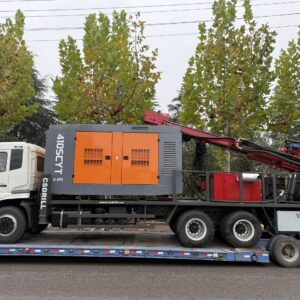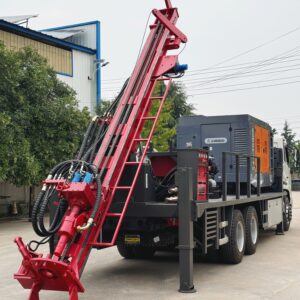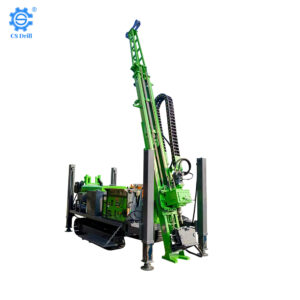The debate between DTH (Down-the-Hole) drilling and top hammer drilling has been ongoing in the construction and mining industries. Each method offers distinct advantages, and the right choice often depends on the specific project requirements. In this article, we will explore both DTH and top hammer drilling, comparing their efficiency, cost, and suitability for different drilling conditions. By the end, you’ll have a clearer understanding of whether DTH drilling is better than top hammer drilling for your needs.
Understanding DTH Drilling
DTH drilling involves the hammer being located at the bottom of the drill string, directly behind the drill bit. Compressed air drives the hammer, which strikes the drill bit to break through the rock. This method is widely used in deep drilling applications, especially in hard rock environments.
Advantages of DTH Drilling
DTH drilling offers several benefits. Firstly, it provides excellent precision, ensuring the hole is straight and accurate. This is critical for applications like foundation drilling, geothermal wells, and deep blast holes in mining. Secondly, DTH drilling is highly effective in hard rock conditions, delivering efficient penetration rates without compromising on accuracy.
Another key advantage of DTH drilling is that it produces less vibration compared to top hammer drilling. This reduces wear and tear on the drill string and makes it more suitable for deeper holes. Additionally, the drilling process is quieter, which is an added benefit in urban or noise-sensitive areas.
Understanding Top Hammer Drilling
Top hammer drilling, in contrast, features a hammer located at the top of the drill string. This hammer delivers rapid blows to the drill bit through the rods, breaking the rock as the bit rotates. Top hammer drilling is often used for shallow to medium-depth drilling applications, especially in quarries and surface mining.
Advantages of Top Hammer Drilling
Top hammer drilling is known for its high-speed performance, particularly in shallower drilling operations. It’s efficient in soft to medium-hard rock, and the equipment used for top hammer drilling is generally more affordable and easier to maintain compared to DTH drilling systems. The lighter equipment also makes top hammer drilling a more mobile option, enabling quick setup and teardown.
For drilling operations where the required depth is less than 30 meters, top hammer drilling is typically preferred due to its speed and cost-effectiveness. Additionally, in situations where rock fragmentation is more important than precision, top hammer drilling can deliver better overall results.
DTH vs. Top Hammer: Key Differences
When comparing DTH and top hammer drilling, several key differences emerge. One of the most important is the depth capability. DTH drilling is more suitable for deeper holes, often exceeding depths of 30 meters, whereas top hammer drilling performs best in shallower applications.
Another critical difference is the type of rock being drilled. DTH drilling excels in hard, abrasive rock conditions due to its straight and accurate drilling, while top hammer drilling is more efficient in soft to medium rock where faster penetration rates are necessary. The choice between DTH and top hammer is often dictated by the hardness of the rock and the required hole depth.
Vibration is another factor to consider. Top hammer drilling generates more vibration, which can lead to increased wear on the drill string and potentially impact accuracy. On the other hand, DTH drilling produces less vibration, making it the better option for applications requiring straight holes and minimal equipment wear.
Cost Considerations in DTH and Top Hammer Drilling
Cost is an essential factor when choosing between DTH and top hammer drilling. While DTH drilling offers greater precision and depth, it typically comes with a higher upfront cost. The equipment is more expensive, and the operating costs, including air compressors, can add up quickly. However, for deep drilling projects where accuracy is paramount, the extra expense may be justified.
Questions and Answers About DTH and Top Hammer Drilling
In contrast, top hammer drilling is generally less expensive in terms of both equipment and operating costs. For projects requiring less depth, top hammer drilling can be a more budget-friendly option, especially in softer rock formations. The faster penetration rates also contribute to reduced overall project costs in many surface drilling applications.
Q: When should I use DTH drilling?
A: DTH drilling is best suited for deep drilling projects, particularly in hard rock conditions where precision and accuracy are critical. It is commonly used in mining, geothermal wells, and deep foundation drilling.
Q: Is top hammer drilling faster than DTH?
A: Yes, top hammer drilling is generally faster than DTH drilling for shallow to medium-depth applications. It is particularly efficient in softer rock formations, where speed is more important than precision.
Q: Which method is more cost-effective?
A: Top hammer drilling tends to be more cost-effective for shallow drilling projects, as the equipment is less expensive, and the operating costs are lower. DTH drilling, while more expensive, offers greater precision and depth for specialized applications.
Q: Can DTH drilling be used for shallow holes?
A: While DTH drilling can be used for shallow holes, it is typically reserved for deeper applications where its precision and reduced vibration provide significant advantages over top hammer drilling.
Q: Does DTH drilling cause less wear on equipment?
A: Yes, DTH drilling generates less vibration, which reduces wear and tear on the drill string and other components. This makes it a better option for projects requiring deep, straight holes.
In conclusion, the choice between DTH drilling and top hammer drilling depends on the specific project requirements. If your project demands deep, precise drilling in hard rock, DTH is likely the better option. However, for shallower drilling operations in softer rock, top hammer drilling offers faster performance and lower costs. Understanding these differences will help you select the right method for your drilling needs.





